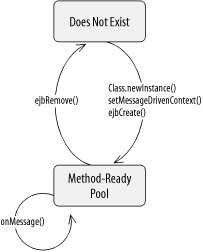The Life Cycle of a Message-Driven Bean
Just as the entity and session beans have well-defined life cycles, so does the MDB bean. The MDB instanceâs life cycle has two states: Does Not Exist and Method-Ready Pool . The Method-Ready Pool is similar to the instance pool used for stateless session beans.[41] Figure 12-4 illustrates the states and transitions that an MDB instance goes through in its lifetime.

Figure 12-4. MDB life cycle
Does Not Exist
When an MDB instance is in the Does Not Exist state, it is not an instance in the memory of the system. In other words, it has not been instantiated yet.
The Method-Ready Pool
MDB instances enter the Method-Ready Pool as the container needs them. When the EJB server is first started, it may create a number of MDB instances and enter them into the Method-Ready Pool. (The actual behavior of the server depends on the implementation.) When the number of MDB instances handling incoming messages is insufficient, more can be created and added to the pool.
Transitioning to the Method-Ready Pool
When an instance transitions from the Does Not Exist state to the
Method-Ready Pool, three operations are performed on it. First, the
bean instance is instantiated when the container invokes the
Class.newInstance( )
method on
the MDB class. Second, the
setMessageDrivenContext( ) method is invoked by the container providing the MDB instance with a reference ...
Get Enterprise JavaBeans, Fourth Edition now with the O’Reilly learning platform.
O’Reilly members experience books, live events, courses curated by job role, and more from O’Reilly and nearly 200 top publishers.

